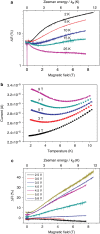Control of exciton spin statistics through spin polarization in organic optoelectronic devices
- PMID: 23149736
- PMCID: PMC3514489
- DOI: 10.1038/ncomms2194
Control of exciton spin statistics through spin polarization in organic optoelectronic devices
Abstract
Spintronics based on organic semiconductor materials is attractive because of its rich fundamental physics and potential for device applications. Manipulating spins is obviously important for spintronics, and is usually achieved by using magnetic electrodes. Here we show a new approach where spin populations can be controlled primarily by energetics rather than kinetics. We find that exciton spin statistics can be substantially controlled by spin-polarizing carriers after injection using high magnetic fields and low temperatures, where the Zeeman energy is comparable with the thermal energy. By using this method, we demonstrate that singlet exciton formation can be suppressed by up to 53% in organic light-emitting diodes, and the dark conductance of organic photovoltaic devices can be increased by up to 45% due to enhanced formation of triplet charge-transfer states, leading to less recombination to the ground state.
Figures




Similar articles
-
Complete polarization of electronic spins in OLEDs.Nat Commun. 2021 Apr 6;12(1):2071. doi: 10.1038/s41467-021-22191-3. Nat Commun. 2021. PMID: 33824319 Free PMC article.
-
The role of spin in the kinetic control of recombination in organic photovoltaics.Nature. 2013 Aug 22;500(7463):435-9. doi: 10.1038/nature12339. Epub 2013 Aug 7. Nature. 2013. PMID: 23925118
-
Influence of Spin-Dependent Polaron Pair Charge Recombination Rates on Singlet Exciton Yields of Fluorescent Organic Light-Emitting Diode Materials.J Phys Chem A. 2025 Apr 17;129(15):3445-3454. doi: 10.1021/acs.jpca.4c08704. Epub 2025 Apr 8. J Phys Chem A. 2025. PMID: 40197019
-
Singlet-to-triplet interconversion using hyperfine as well as ferromagnetic fringe fields.Philos Trans A Math Phys Eng Sci. 2015 Jun 28;373(2044):20140326. doi: 10.1098/rsta.2014.0326. Philos Trans A Math Phys Eng Sci. 2015. PMID: 25987575 Free PMC article. Review.
-
Reverse intersystem crossing from upper triplet levels to excited singlet: a 'hot excition' path for organic light-emitting diodes.Philos Trans A Math Phys Eng Sci. 2015 Jun 28;373(2044):20140318. doi: 10.1098/rsta.2014.0318. Philos Trans A Math Phys Eng Sci. 2015. PMID: 25987570 Free PMC article. Review.
Cited by
-
Optical coupling of individual air-suspended carbon nanotubes to silicon microcavities.Proc Jpn Acad Ser B Phys Biol Sci. 2024;100(6):320-334. doi: 10.2183/pjab.100.022. Proc Jpn Acad Ser B Phys Biol Sci. 2024. PMID: 38866479 Free PMC article. Review.
-
Floquet spin states in OLEDs.Nat Commun. 2021 Jan 19;12(1):465. doi: 10.1038/s41467-020-20148-6. Nat Commun. 2021. PMID: 33469009 Free PMC article.
-
Room temperature magneto-optic effect in silicon light-emitting diodes.Nat Commun. 2018 Jan 26;9(1):398. doi: 10.1038/s41467-017-02804-6. Nat Commun. 2018. PMID: 29374170 Free PMC article.
-
Complete polarization of electronic spins in OLEDs.Nat Commun. 2021 Apr 6;12(1):2071. doi: 10.1038/s41467-021-22191-3. Nat Commun. 2021. PMID: 33824319 Free PMC article.
-
Unraveling the Characteristic Shape for Magnetic Field Effects in Polymer-Fullerene Solar Cells.ACS Omega. 2017 Nov 10;2(11):7777-7783. doi: 10.1021/acsomega.7b01470. eCollection 2017 Nov 30. ACS Omega. 2017. PMID: 31457335 Free PMC article.
References
-
- Friend R. H. et al. Electroluminescence in conjugated polymers. Nature 397, 121–128 (1999)
-
- Brabec C. J. et al. Polymer–Fullerene Bulk-Heterojunction solar cells. Adv. Mater. 22, 3839–3856 (2010) - PubMed
-
- Clarke T. M., Durrant J. R. Charge Photogeneration in organic solar cells. Chem. Rev. 110, 6736–6767 (2010) - PubMed
-
- Davis A. H., Bussmann K. Organic luminescent devices and magnetoelectronics. J. Appl. Phys. 93, 7358–7360 (2003)
-
- Bergenti I. et al. Spin polarised electrodes for organic light emitting diodes. Org. Electron. 5, 309–314 (2004)
Publication types
LinkOut - more resources
Full Text Sources
Other Literature Sources

